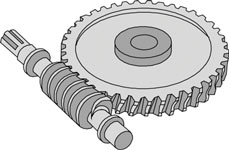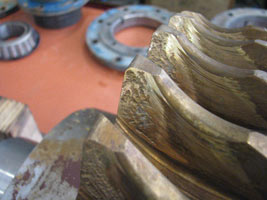The Effects of EP Additives on Gearboxes
Oil additives offer a wide range of benefits, but in some circumstances they can actually be harmful to the machines in which they are added. For example, let’s look at worm gearboxes. These machines have gearing composed of yellow metal (typically bronze). Certain extreme pressure (EP) additives can chemically react with these softer metals, causing premature wear and even failure.
 Worm gearboxes are mainly comprised of two units: the worm and the worm wheel. The worm is what actually drives the worm wheel. It is a rod with a helical ridge on its surface that allows it to mesh with the teeth of the worm wheel to provide rotary motion.
Worm gearboxes are mainly comprised of two units: the worm and the worm wheel. The worm is what actually drives the worm wheel. It is a rod with a helical ridge on its surface that allows it to mesh with the teeth of the worm wheel to provide rotary motion.
These gearboxes are great for achieving high reduction ratios as well as high torque. In order to increase either of these values, the worm wheel is made larger in diameter. The larger circumference the worm wheel has, the greater the speed reduction and the greater amount of torque will be imparted through the exit shaft.
Generally, the worm is made of steel, while the worm wheel is made of a yellow metal. However, in some cases, both the worm and worm wheel are steel, or they both may be yellow metals. The worm is always harder than the wheel.
Yellow metals, as the name suggests, are yellowish in color. They are alloys that contain copper. A standard definition would be a type of brass having about 60 percent copper and 40 percent zinc. Bronze is another type of yellow metal. These metals have been used for centuries to form gears and other components of simple machines.
Copper Strip Corrosion Test
An easy way to determine which form of sulfur is being utilized in your EP oil is to look at the results of the copper strip corrosion test (ASTM D130). In this test, a strip of copper is immersed in the fluid to be tested at 40 degrees C and again at 100 degrees C. The strip is removed after each test and checked for staining of the copper. The results range from very little to no staining (1a) all the way to very dark stains (4c). If the results are in the area of 1b to 2a, then the yellow metals in your worm gearboxes could be at risk for chemical attack.
EP additives that contain sulfur cause the most damage to these types of metals. Two different types of sulfur may be used within these additives. The first type is active sulfur. Sulfur in its active state readily reacts with metal surfaces to form a ductile metal soap that is sacrificial and allows opposing surfaces to contact one another with minimal damage. Active sulfur is chemically aggressive, and with yellow metals being softer than steel, they can begin to pit and form spalls due to this chemical attack.
Rising temperatures can increase the rate at which this reaction takes place. This is explained by the Arrhenius rate rule, which states that the rate of a chemical reaction doubles for every increase of 10 degrees C (18 degrees F) in oil operation temperature.

The second type of sulfur used within EP additives is inactive sulfur. It is less likely to bond to surfaces and react chemically.
Active sulfur in some EP additives reacts with the copper within the brass or bronze. Sulfur, when in contact with copper along with the presence of heat, forms copper sulfide. This simple chemical reaction can have devastating repercussions on the reliability of machines. In extreme pressure situations, copper disulfide can be formed. Both of these crystalline forms of copper are very hard and can cause abrasive damage to soft machine surfaces.
With all the risks associated with chemical attacks on yellow metals, why make gears using these metals in the first place? Brass and bronze are easy to machine into different shapes and yet have good strength and hardness. It all comes down to economics. When you factor in machining costs and raw materials costs, yellow metals are a very cost-effective alternative to steel.
 In addition, brass properties are easily changed by incorporating different metals into the metallurgy. For instance, lead can be added for enhanced machinability. For increased corrosion resistance, aluminum or tin can be added into the makeup of the alloy. The possibilities are endless for the types of alloys you can make with brass and bronze.
In addition, brass properties are easily changed by incorporating different metals into the metallurgy. For instance, lead can be added for enhanced machinability. For increased corrosion resistance, aluminum or tin can be added into the makeup of the alloy. The possibilities are endless for the types of alloys you can make with brass and bronze.
By understanding some simple chemistry and reading the product data sheets of the lubricants you put into your gearboxes, you can increase reliability. When adding EP oil to gearboxes containing yellow metals, remember to check the copper strip corrosion test (ASTM D130) to help predict if there will be any issues with compatibility of the metallurgy within these machines.
